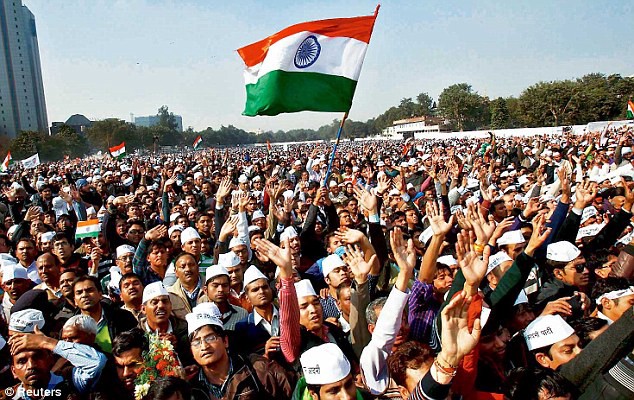
In the United States, and many other western countries with the two-party system, the two major political parties operate on the basis of discernibly disparate political ideologies. However, in India, the ideological lines that separate the various political parties aren’t as distinctive. The regional political parties operate in their own distinctive states; for example, the Samajwadi Party operates primarily in Uttar Pradesh, AAP is based in Delhi NCR, and the Shiv Sena is based in Maharashtra. The two major national parties, Bharatiya Janata Party, and Congress, however, have no distinctive separate regional bases; more importantly, their ideological differences, too, are slowly dissipating.
The BJP was founded as a political party with a focus on Hindu nationalism. They primarily catered to the majority Hindu population. Congress, on the other hand, was founded as a secular party run by individuals of all major Indian religions, with a particular focus on securing minority rights[1]. Recently, though, much of this has changed. BJP, in a bid to gain more voters, has attempted Muslim appeasement tactics. On the other hand, Congress leaders have been trying to attract the Hindu demographic by fervently engaging in Hindu rituals in highly publicised settings. Congress leaders have been a part of countless photo-ops at Hindu temples, nearly always accessorised with noticeable religious trappings. Congress and BJP are both trying to attract a similar voter demographic; thus, their analogous political agenda has lead to increasingly similar political ideologies (at least, ostensibly). It is also important to note that in Indian politics, stances on religion —and more recently, caste —have traditionally been the primary identifiers of political ideology. So, the parties’ changing religious policies and appeasement tactics are crucial identifiers of changing ideology.
Recently, some political parties temporarily housed their MLAs in hotels, as form of quasi-house arrest, to keep them from switching to a different party. The party leadership justified this move as a way of preventing other political parties from poaching the MLAs. Interestingly, this wasn’t a one-off incident; Shiv Sena and Congress did this to prevent BJP from poaching the MLAs, while BJP did this to prevent the latter parties from poaching. The ease with which parties can “poach” senior politicians from different parties reveals a shocking lack of loyalty to their party.
In response to the diminishing ideological differences between the two major political parties; many prominent politicians have frequently been switching between parties. Jyotiraditya Scindia, of Madhya Pradesh, in 2020, was first prominent politician to make the switch from Congress to BJP. 21 Members of Legislative Assembly (MLAs) immediately followed suit, in a bid to display their personal loyalty to Scindia. Political speculation suggests that Scindia left the Congress because the Congress refused to give him a leadership role. For Scindia, personal political gain and mileage was more important than loyalty to a party and its (supposed) ideologies. Scindia is not alone in this matter. Many high-profile politicians have recently switched between political parties to get more personal political mileage and better leadership positions. Aparna Yadav, of the famous Yadav political family, moved to the SP from the BJP after a dispute over an election ticket. Michael Lobo of Goa left the BJP and moved to Congress because he felt sidelined by the BJP. These are just a few examples from a swarm of politicians who’ve made quick switches between political parties just to further their own political careers, without any consideration for party ideology or policy goals. This rapid switching of key politicians from one party to another is a departure from the “traditional party system” that is considered a key aspect of a functional democracy[2].
Instead of working towards policy goals along with their party members, the primary motive of most Indian politicians is gaining political clout and maintaining their personal political hegemony. This, according to Ozan Varol, is one of the key motivations of stealth authoritarians. Varol argues that advocacy for political ideology is a key aspect of stealth authoritarianism, which these politicians do not exhibit. However, in this case, the lack thereof could be reflective of stealth authoritarianism[2].
Rob Lieberman et al proposed a theory that “polarised two-party presidentialism” is one of the conditions that lead to democratic erosion in the United States[4]. In India, the inverse is true; the lack of polarisation on the basis of ideology suggests erosion.
1 Choudhary, Vikas K. 2021. “The Idea of Religious Minorities and Social Cohesion in India’s Constitution: Reflections on the Indian Experience” Religions 12, no. 11: 910. https://doi.org/10.3390/rel12110910
2 Ellen Lust and David Waldner, Unwelcome Change: Understanding, Evaluating, and Extending Theories of Democratic Backsliding, 2015. Washington, DC: USAID
3 Ozan Varol, “Stealth Authoritarianism,” Iowa Law Review 2015
4 Robert Lieberman et al., “The Trump Presidency and American Democracy: A Historical and Comparative Analysis,” Perspectives on Politics 2018, pp.

0 Comments